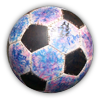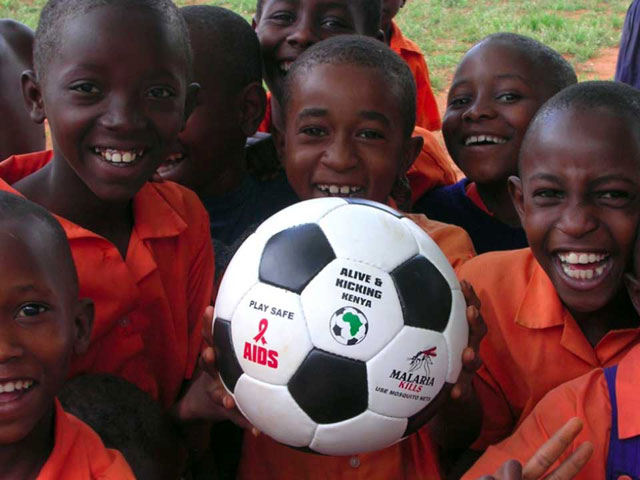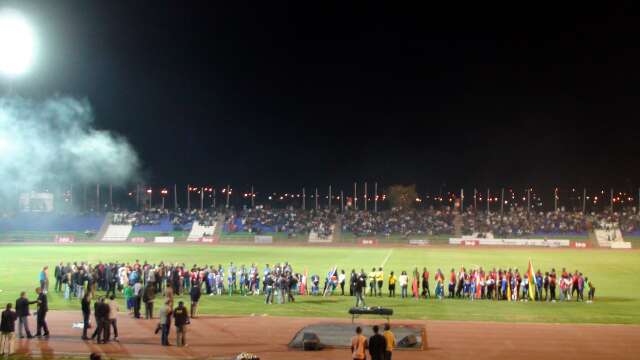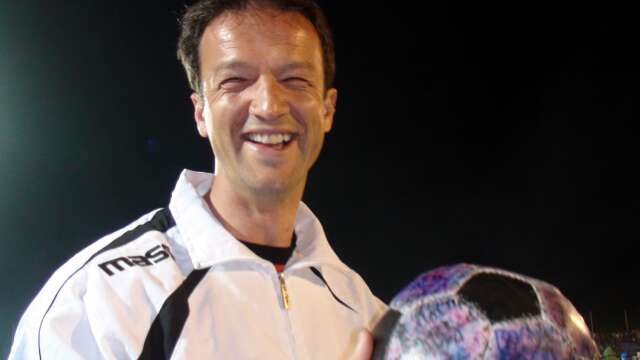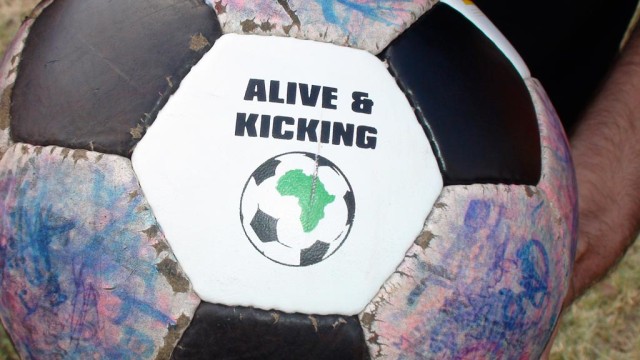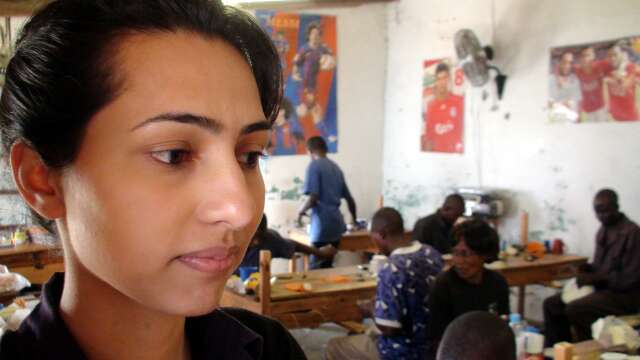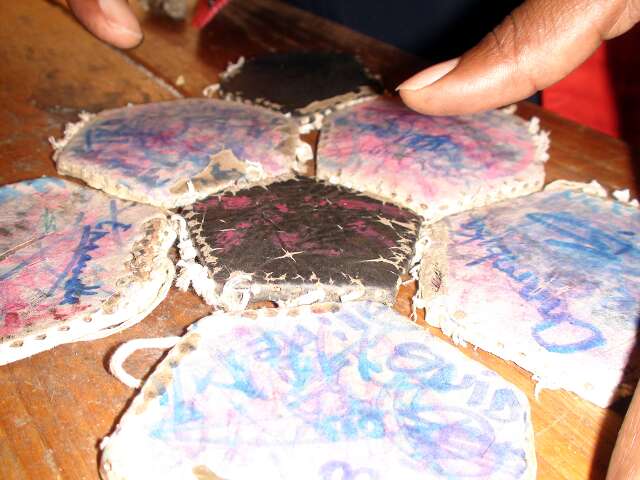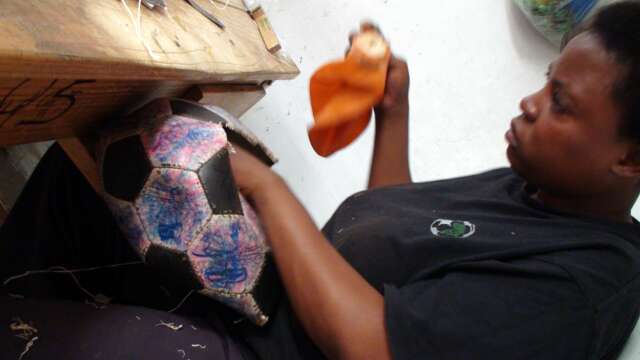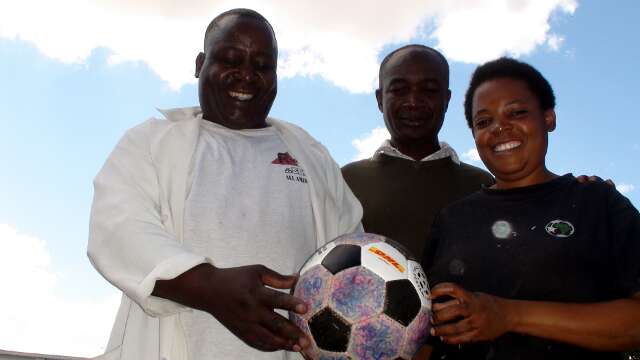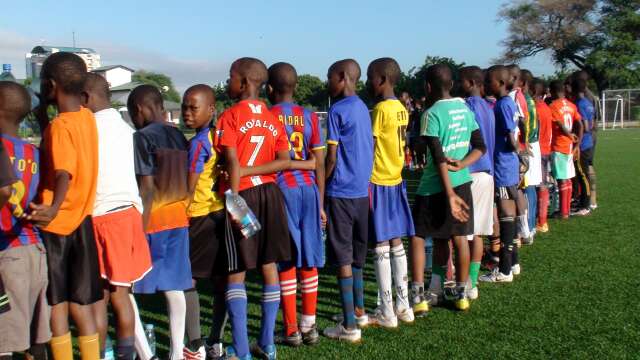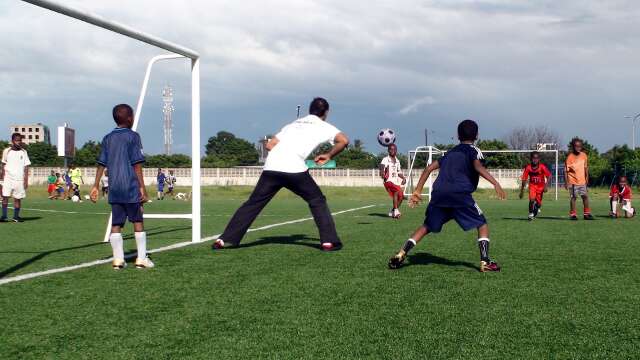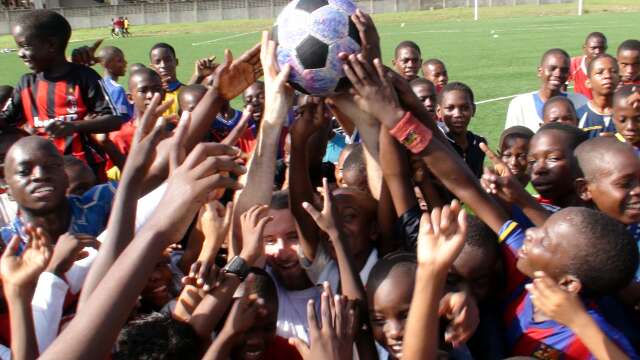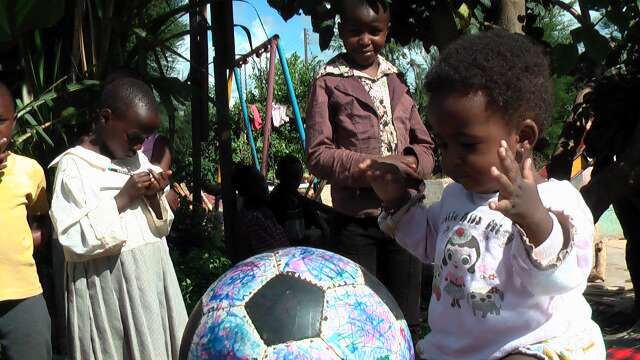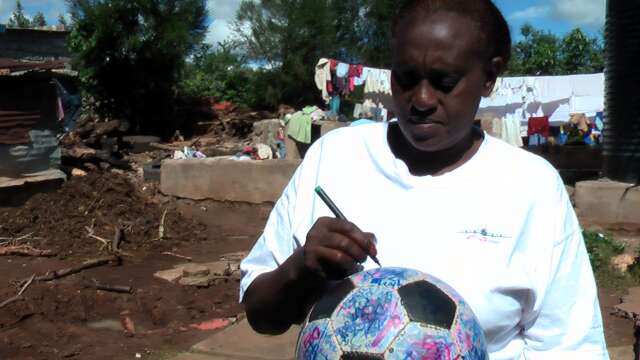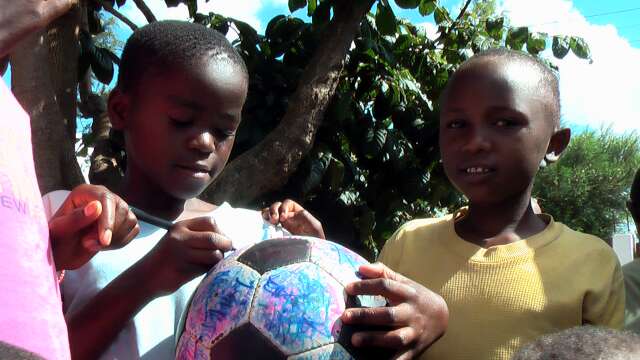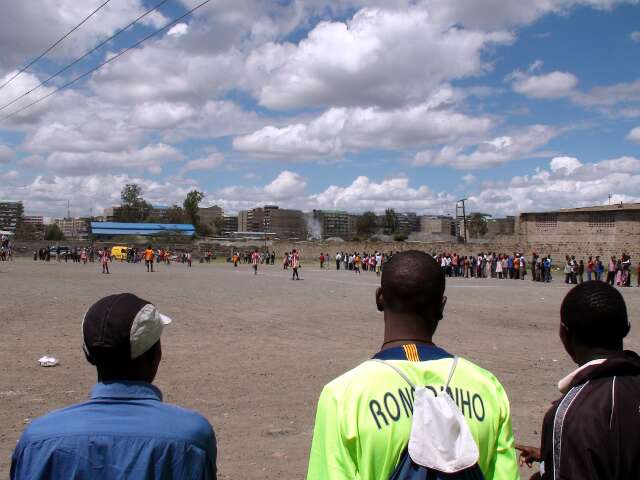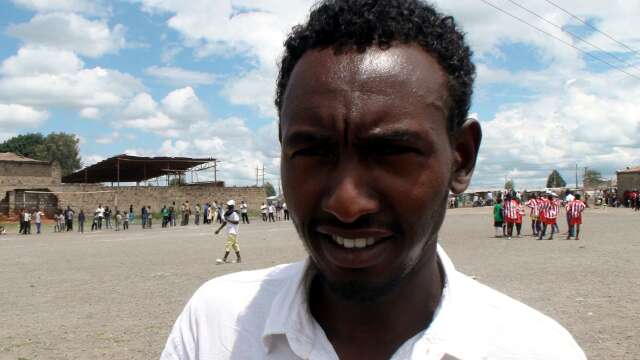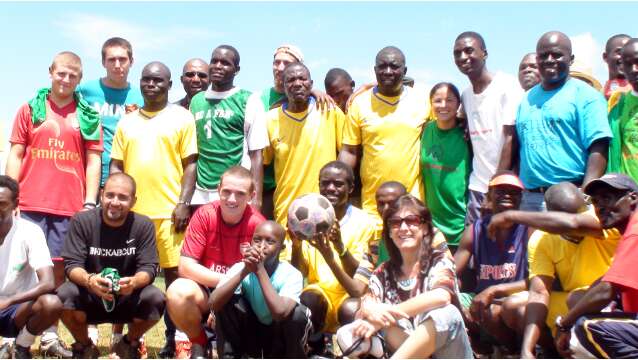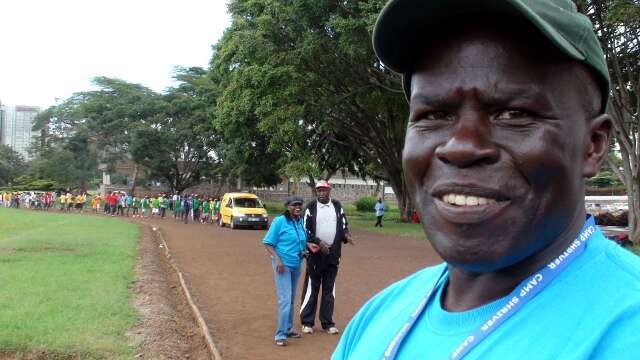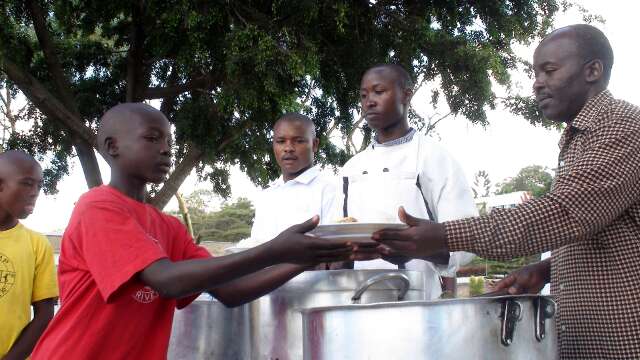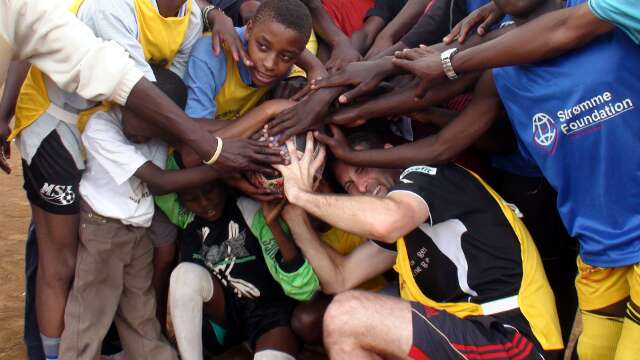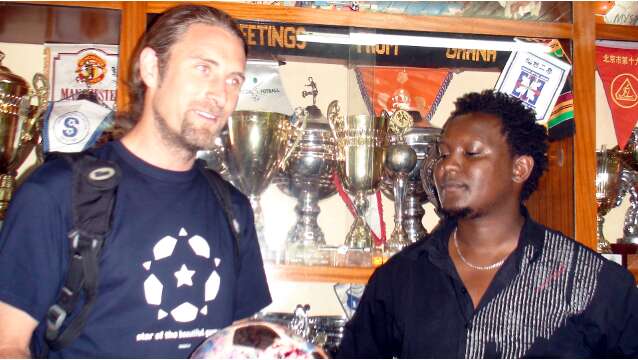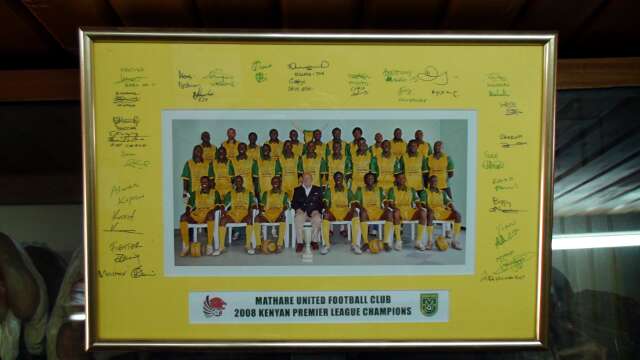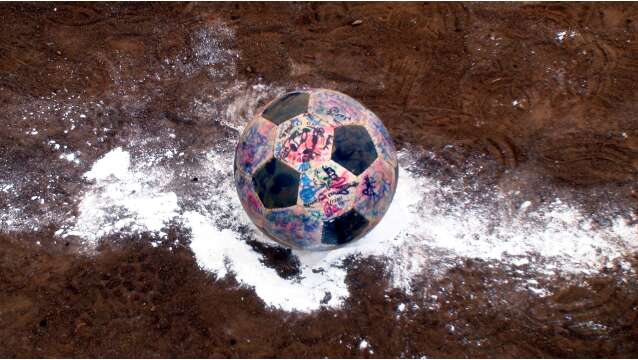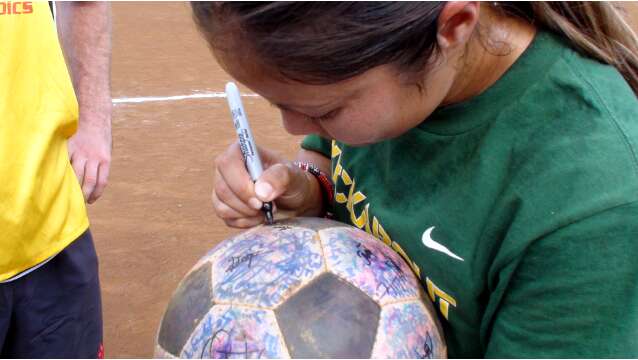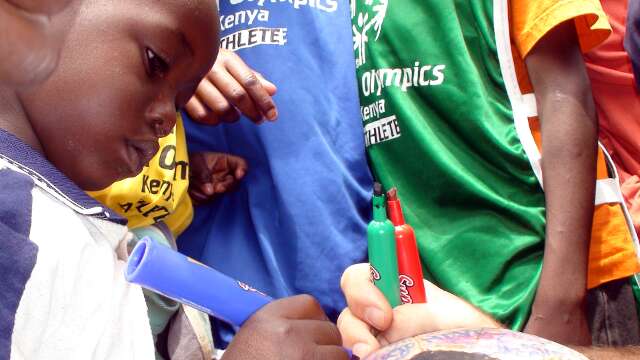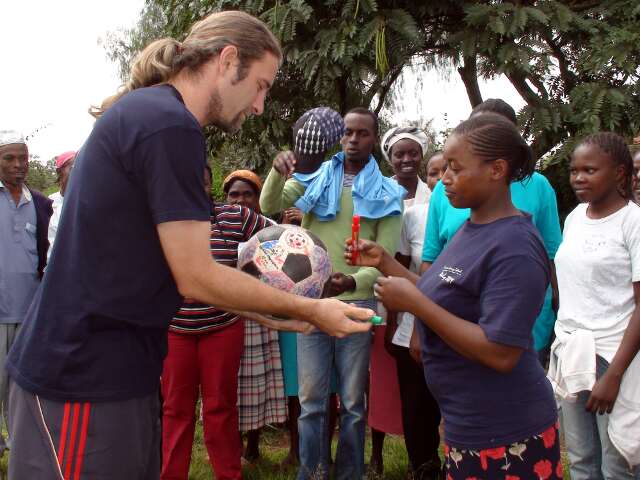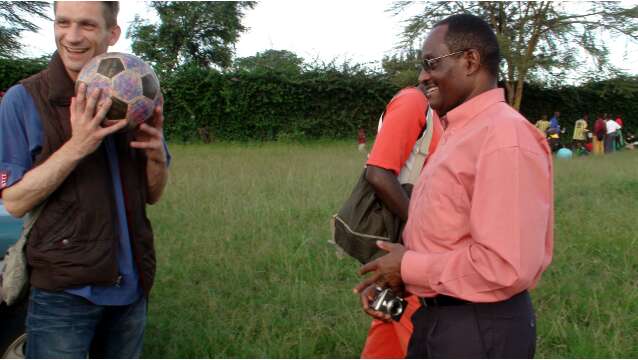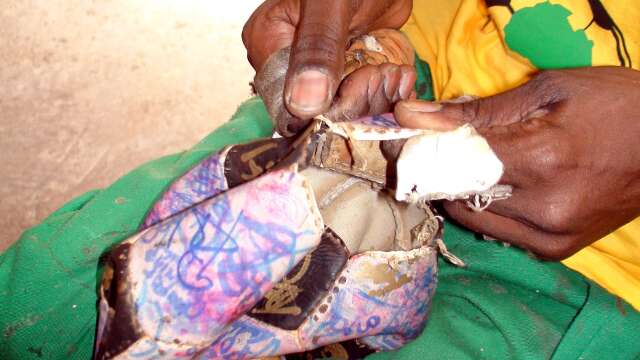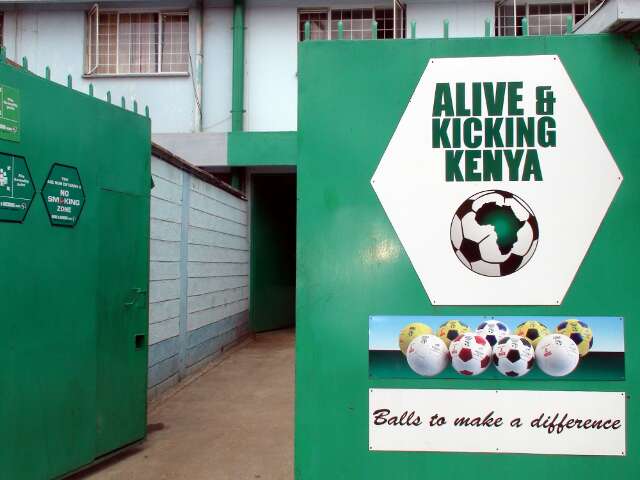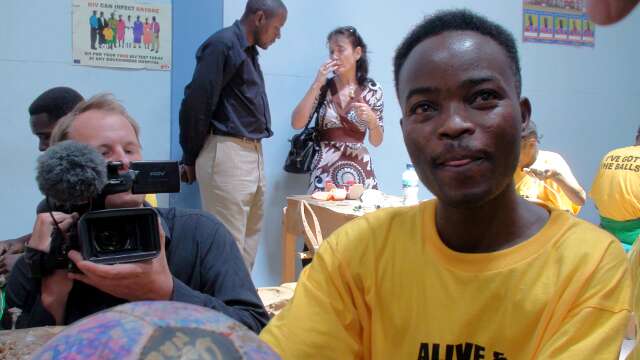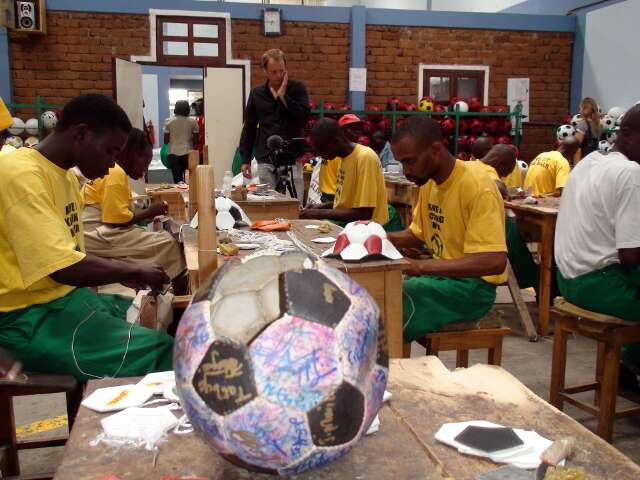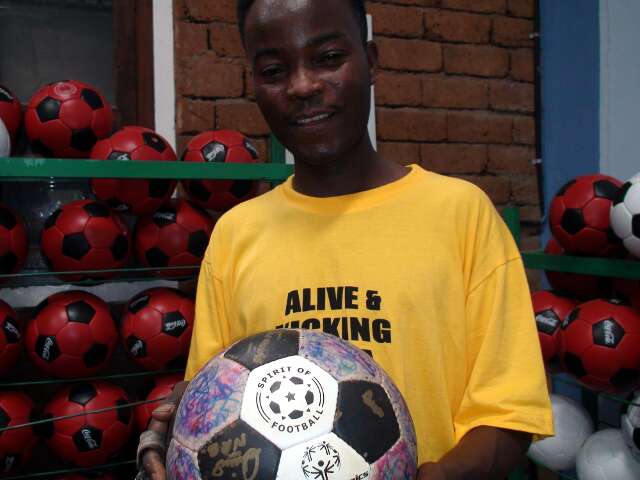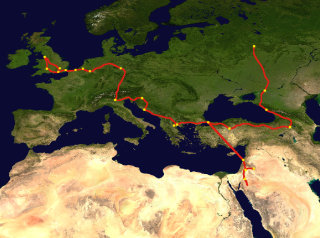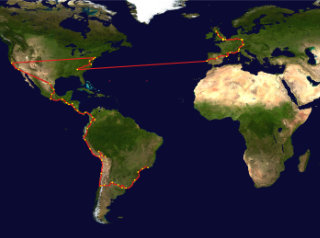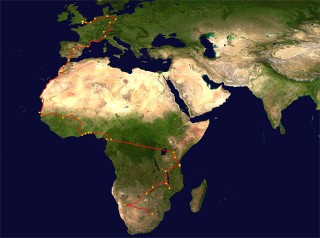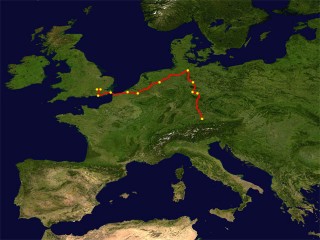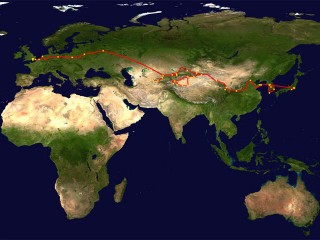We stop by Independence Stadum in Windhoek for a game of football with a difference. Winton Rufer, from as far away as New Zealand, has travelled over 24 hours to arrive in time for kick-off. Other former stars, like 2002 World Cup Finalist Jens Novotny, have jetted in from Germany. Former Danish National Team player and regular at Bolton Wanderers, Stig Tofting, arrives from England. African legends have come in, thanks to Air Namibia, from all over Africa. Global FC have jetted in from all over the world to raise awareness for the very important global issue: climate change.
After the match, we have a chance to talk to German legend Mario Basler about the Spirit of Football.
“Football is a team game. Everybody can take part in this game. If you are rich if you are poor. It doesn’t matter, you can play football. On the beach. On the streets… everywhere. That is why football is sport number one in the world.”
“Yesterday, we went to a township with one ball. I asked the kids if they would like to play football with us. And there was no question for them to say yes and to play football with us. This is the spirit of football.”
The Ball’s been on the road for well over one hundred days now. Its been played in perhaps seven hundred kick-abouts — on streets, in parks, it even joined the mile-high kick club when it was kicked by pilots in the cockpit en route to Lagos. The Ball has been around the block and it’s starting to look a little worse for wear. Luckily, our partner Alive & Kicking has a stitching centre in Lusaka.
Christian hasn’t seen The Ball being operated on. And the anguished look on his face as The Ball doctor opens The Ball up is one that any worried parent can relate to. His eyes bulge, his mouth gapes… he looks white as a sheet (well, he always does — he’s English).
Before long, five panels have been removed.
The Ball doctor still isn’t satisfied and looks to get cracking on the bladder. “Stop! Please. Now”, says Christian. She does.
We’ve brought a bladder and a few spare panels from Nairobi. Alive and Kicking provide a few Zambian panels too. The Ball is becoming more African by the day!
The operation is a success but The Ball looks very strange. Even stranger than it did in Nairobi after having 2 panels replaced. The Ball looks rather like the result of a serious head-on ball collision. Two balls have merged into one.
It is going to take a live kicking or ten before The Ball can bounce evenly again.
Maximo was right. It’s 7am on Saturday morning and children from all over Dar es Salaam are assembling at the Tanzanian Football Federation’s artificial turf pitch. Children from as young as six and up to twelve arrive carrying their boots and water bottles, ready for a morning training session.
TFF trainers start working with the older children, Christian heads off to play keepie-uppie with the youngest, while Blaise and Andrew jump in with corner practice for the rest. Blaise’s goalkeeping prowess is soon receiving plenty of praise and the children ask him if he’s a professional. It’s hard for him to conceal his pride at the very thought of this.
Blaise seems genuinely touched by the passion and commitment of the children and, as the session comes to close, asks whether the children can join us at the Uhuru Stadium for the seven-a-side tournament that has been organised for local schoolkids. It’s a deal — they will all be coming along.
“You won’t get a better reception in all of Kenya,” Tish Pearson of the Robert Grace Foundation tells Christian before he heads off for Nairobi. The St Paul’s Orphanage, just outside Nairobi, is supported by the foundation. “We’d be delighted if The Ball could visit the children there.”
Leaving Andrew back at base, Christian goes off to visit the orphanage with Joe Mutua, Regional Director of Special Olympics. The Ball is warmly received — although, to Christian’s surprise, few of the children are actually football enthusiasts. Nevertheless, everyone kicks and signs The Ball and laughs and smiles are everywhere.
Joe talks at length to Margaret, the “mother” of the orphanage. He discovers that 15 of the children at the home are intellectually disabled. He immediately arranges for them to take part in Special Olympics sporting events in the future (SO do sports other than football, of course) and suggests that two of the older residents, James and Carol, be trained by Special Olympics to offer sports coaching locally.
Joe also puts Margaret in touch with Alive & Kicking, who made The Ball here in Nairobi, and tells her that this will almost certainly result in the donation of footballs to the home. He also promises to make sure that Margaret is put in contact with MYSA, who also offer sporting activities and other social support locally.
It seems to be an innate feature of The Ball that it makes connections wherever it goes, whether between people or between organisations. And today, it seems that the connection that has been made with Joe at Special Olympics will result in some real, tangible and lasting benefits for the children of St Pauls.
“It’s called Score Against Substance Abuse,” Wario says. Behind him, on the touchline, two kids are sniffing glue from plastic bags. Andrew starts to warm up for a game. We look down. The football field appears to be covered in glass. A shiver goes down Andrew’s spine.
Wario Donne has been in contact with us since before The Ball left England. He’s been extolling the virtues of football in his work with youngsters in one of Nairobi’s largest and most notorious slums. His mission is to offer them a vision of life that offers them more than the attractions of drugs and crime. And he wants us to see how well it works. We go along with a contingent from Special Olympics Kenya who are keen to link up with SASA.
Can’t you clear the pitch of that glass?” we ask Wario. “Not really, the field is glass,” he replies. “We’d have to dig down six inches before we find anything other than glass.” No sliding tackles today then, Andrew thinks to himself. As Andrew carefully avoids going to ground on the field, Christian watches the action unfold from the touchline.
“What’s going on?” a bystander asks him.
“It’s Unified Football,” Christian explains, “people with intellectual disabilities and people without play in the same team.”
“Which ones are disabled?”
A pause. Christian smiles. A light goes on in the guy’s head.
“Thank you,” he says, “I understand now.”
You can’t stop kids sniffing glue. But you can offer them an alternative. Wario is engaging young people in playing football. He’s offering them the chance to join a team, make friends and compete in regular tournaments. And maybe the light will go on in the heads of those young people. Like it did with the guy Christian met on the touchline.
An early roll-call at Nairobi University today for the main Special Olympics event in Kenya. Athletes, parents, supporters and players are already assembled as we pile out of the DHL van with The Ball.
A parade around the pitch is followed by Unified Football. Sides run on to the pitch and, unusually, the captains meet at the centre-spot to decide the length of time they will play for. On this sweltering cloudless day, they opt for shorter halves than perhaps they would otherwise. “Thirty minute halves” comes the opening bid. The other captain looks up at the sky and the blazing sun and with sweat already forming on his forearms he replies: “15 minutes each way”. Every good haggle results in a compromise and twenty minutes each way is settled on. The result is fast and furious action, enjoyed by players and spectators alike.
And so to the main event — a team of Kenyan footballing legends takes the field to warm up for a game against a unified team of local Special Olympians and travelling football crews. Their team sheet reads like a who’s who of Kenyan football: Aggrey Lukoye, Josephat Murila, Tobias Ochola, Austin Oduor and Elly Adero are all in the starting line-up. Andrew is joined by Lorrie and Brian from Kickabout and two coaches from Arsenal, who have just arrived from Vietnam to give football training sessions with local NGOs.
It is a closely fought game, neither side giving an inch. Andrew scores a goal with a flying header, scuffing up his knees quite severely in the process. But it’s worth it — goal of the game, no doubt about it. The final score? It didn’t matter — the handshakes, the smiles, the memories were what this day was all about.
But the highlight of the event for us? Seeing everyone given a proper meal after the game, the Special Olympics athletes first in line, just as they should be.
“The most important book of my generation was ‘The Joy of Sex’ but if I were to write a book, I’d call it ‘The Joy of Football'”
— Bob Munro, MYSA Founder and Chairman
In the world of football for development, the Mathare Youth Sports Association (MYSA) needs little introduction. Nominated twice for a Nobel Prize, this organisation which began humbly in the impoverished Mathare slum has touched the lives of more than 150,000 people in Nairobi. It is recognised throughout the world as a model for how sport can have a positive impact in a disadvantaged community.
John Ndichu Ng’ethe proudly stands in front of an impressive trophy cabinet. He has come through the ranks at MYSA from youth project participant to youth leader to his current post as PR Manager. He tells us in detail and from experience about how the organisation works and what the results have been. MYSA offers us inspiration and encouragement. We recommend checking out their website for the full story.
After hearing their story, we tell the story of The Ball to a packed room. And then it’s on to the reason for our visit, another unified game — a youth team from Mathare United (yes, they have a professional club with players drawn exclusively from MYSA) versus a unified team of Special Olympians, Kickabout and ourselves. Mathare United are clearly superb footballers and toy with the unified team, passing accurately and scoring freely.
Not even the introduction of our ringer, former USA Womens World Cup winner Lorrie Fair, stems the tide. Fair’s more than fair though, and gets a huge cheer from the girls on the touchline — who are clearly impressed by her skill — every time she gets the ball.
The final scoreline is a fitting testament to the success of MYSA. There is no shame in being beaten by the better team. Losing gracefully is one of the most important lessons in the art of taking part.
The traffic enforces our adherence to “Africa-time”. We leave Arthur and Sanna de Leeuw’s house — many thanks for letting us stay with you guys — with Joe Karanga navigating the potholed roads and insane congestion of Nairobi for our first appointment of the day at Kenyatta University.
The sun is blazing already as we arrive and are greeted by Peter Wanderi, a university lecturer who introduces us to his colleagues who volunteer with Special Olympics. We are introduced to a large group of parents of athletes, who are huddled in the only shade around, provided by a small tree at the edge of the playing field where their children are getting sports coaching.
Andrew speaks to them about The Ball and its mission and we are impressed to learn that they have formed their own support network as a result of showing up along with their children every week. They are supported whole-heartedly by staff and students from the university. This really is an extended family. All are invited to sign The Ball — with the usual condition that they kick or head it first. Headers are delivered in quick succession.
Then we are mobbed by the children. There are just too may of them to consider going one by one so we devise a solution. An enormous circle is formed, and The Ball is knocked around allowing everyone to have a touch and a turn in the middle. Then a mass signing takes place: five markers and more than a hundred children with Andrew in the middle somewhere.
The smiles and laughter are testament to the power of The Ball to bring a little light into every situation.
England, Somerset, Radstock, Tuesday evening. I walk downstairs after settling my son, Alistair, in his bed for the night. I have resigned myself to my scheduled flight to Kenya being cancelled indefinitely by the intervention of the Icelandic volcano. The TV is showing the news. My attention is suddenly grabbed. Flights are back on — and mine appears to be one of them. With a start, I realise that I might just have put my son to bed for the last time until July.
Ah, the romance of air travel… where did it go? Come to think of it, did it ever exist? As usual, it’s a case of a few hours of fitful sleep, stopovers and sharing personal space with strangers, customs and immigration officials alike. Finally, touchdown in Nairobi. But luggage delays prevent me from joining Andrew at Alive & Kicking to meet Bernard, the maker of The Ball.
And so Joe Karanga, who meets me at the airport (and has patiently waited for me to emerge with my luggage) whisks me off to a project where Andrew and The Ball are rumoured to be waiting for me. And indeed they are. I haven’t seen Andrew since we parted ways in Casablanca. Then in the distance, there he is, camera in hand, and I break out into a spontaneous “ole ole ole”. Reunited for the final leg through East Africa to the World Cup.
But where is The Ball? Ah, there it is. Or is it? This one looks distinctly worse for wear and is, strangely, a weirdly misshapen.
Andrew explains that many thousands have signed it since I last saw it and that it has just been repaired, two new panels fitted which are smaller than the existing ones, giving it its, ahem, unique shape. Some keepie-uppie immediately reassures me that this is indeed no just any ball — it is The Ball.
What seems like an age ago, The Ball was hit by a car in Abidjan and rushed to hospital. But the wound got bigger and bigger and bigger… eventually it was so big that The Ball had to be taken to see a ball doctor last week in Yaounde, Cameroon, where it got temporary stitches. Now The Ball has returned back to the place in Kenya where it was made.
How would it feel to meet your maker? I get a little bit little nervous for The Ball as it is about to do just that. Bernard is very happy to see The Ball, his creation, again. How different it looks now, covered as it is in over 10,000 signatures and kicked in hundreds of games of football.
Bernard sets about restoring his creation to full health. He removes two wounded panels. He then removes and replaces the bladder in a particularly delicate procedure. It is one of the more difficult operations Bernard has had to undertake. Not least because the press surround him as he works his magic. At last, The Ball is ready to be made whole again — brand new panels are fitted over the gaping hole.
We know it is not just any ball, but The Ball is now huge. It has increased in size considerably due to getting soaked in Dakar, then dried out in the searing heat of Mali and Burkina Faso, then wet and dry again in the high humidity of Atlantic West Africa from the Ivory Coast through to Cameroon.
The Ball is now fit as a fiddle, but slightly groggy and a wee bit out of balance… the new panels are much smaller than the old ones that have stretched from all the wind, water, wear and tear. It bounces in an oddly uneven way now.
Oh well, I suppose it’s nothing that a good kicking won’t fix!
